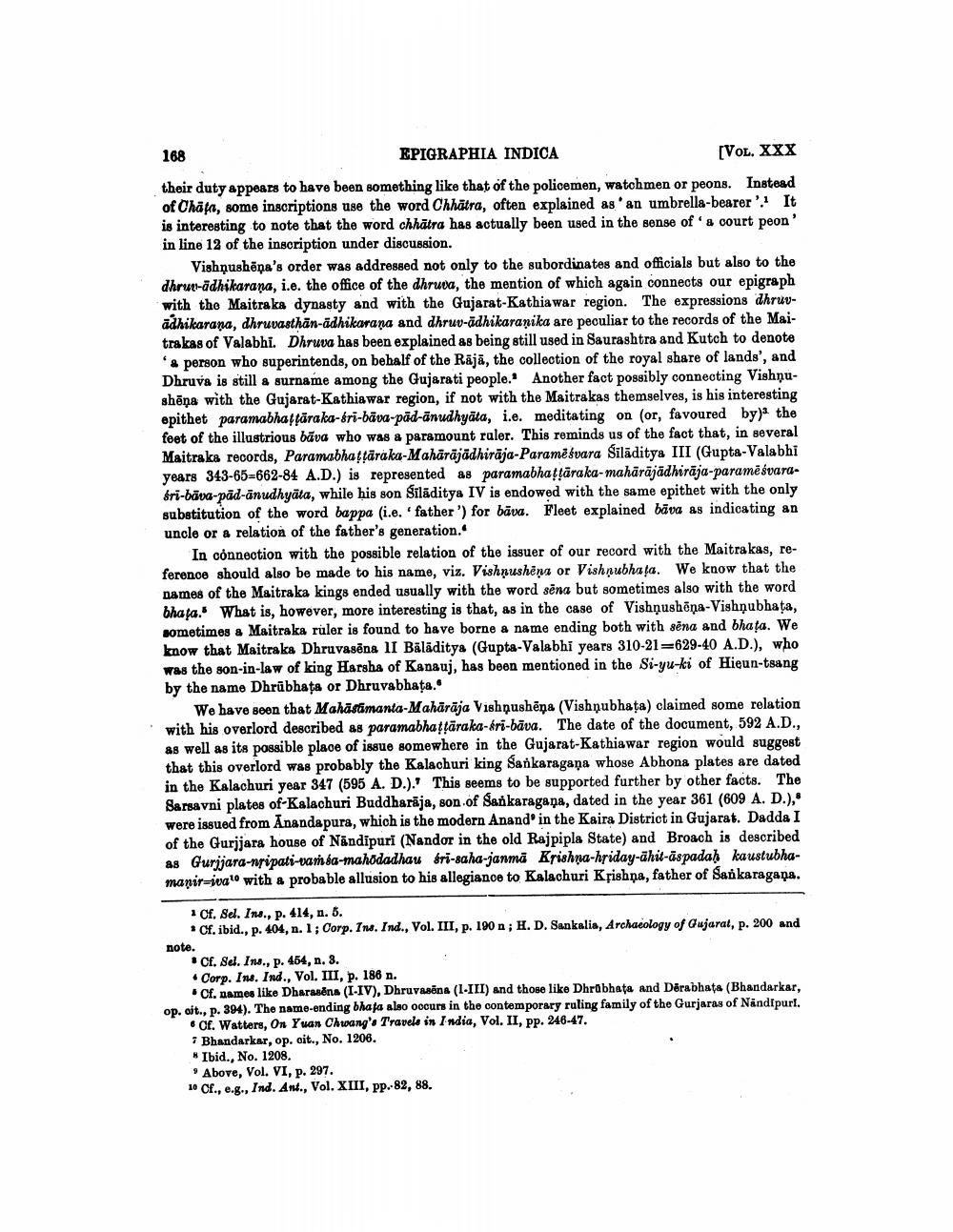________________
168
EPIGRAPHIA INDICA
[VOL. XXX
their duty appears to have been something like that of the policemen, watchmen or peons. Instead of Chata, some inscriptions use the word Chhatra, often explained as an umbrella-bearer'. It is interesting to note that the word chhatra has actually been used in the sense of a court peon' in line 12 of the inscription under discussion.
Vishnushena's order was addressed not only to the subordinates and officials but also to the dhruv-adhikarana, i.e. the office of the dhruva, the mention of which again connects our epigraph with the Maitraka dynasty and with the Gujarat-Kathiawar region. The expressions dhruvadhikarana, dhruvasthan-adhikarana and dhruv-adhikaranika are peculiar to the records of the Maitrakas of Valabhi. Dhruva has been explained as being still used in Saurashtra and Kutch to denote a person who superintends, on behalf of the Raja, the collection of the royal share of lands', and Dhruva is still a surname among the Gujarati people. Another fact possibly connecting Vishnusheņa with the Gujarat-Kathiawar region, if not with the Maitrakas themselves, is his interesting epithet paramabhattaraka-sri-bāva-pād-änudhyāta, i.e. meditating on (or, favoured by) the feet of the illustrious bava who was a paramount ruler. This reminds us of the fact that, in several Maitraka records, Paramabhaṭṭäraka-Mahārājādhirāja-Parameśvara Siladitya III (Gupta-Valabhi years 343-65-662-84 A.D.) is represented as paramabhaṭṭāraka-mahārājādhirāja-paramēśvaraśrī-bāva-pad-änudhyata, while his son Siladitya IV is endowed with the same epithet with the only substitution of the word bappa (i.e. father') for bava. Fleet explained bava as indicating an uncle or a relation of the father's generation."
In connection with the possible relation of the issuer of our record with the Maitrakas, reference should also be made to his name, viz. Vishnushēna or Vishnubhata. We know that the names of the Maitraka kings ended usually with the word sena but sometimes also with the word bhata. What is, however, more interesting is that, as in the case of Vishnushona-Vishnubhata, sometimes a Maitraka ruler is found to have borne a name ending both with sena and bhata. We know that Maitraka Dhruvasena II Baladitya (Gupta-Valabhi years 310-21-629-40 A.D.), who was the son-in-law of king Harsha of Kanauj, has been mentioned in the Si-yu-ki of Hieun-tsang by the name Dhrubhața or Dhruvabhata.
We have seen that Mahasamanta-Mahārāja Vishnushēņa (Vishnubhața) claimed some relation with his overlord described as paramabhaṭṭāraka-kri-bāva. The date of the document, 592 A.D., as well as its possible place of issue somewhere in the Gujarat-Kathiawar region would suggest that this overlord was probably the Kalachuri king Sankaragana whose Abhona plates are dated in the Kalachuri year 347 (595 A. D.). This seems to be supported further by other facts. The Sarsavni plates of Kalachuri Buddharaja, son of Sankaragana, dated in the year 361 (609 A. D.), were issued from Anandapura, which is the modern Anand' in the Kaira District in Gujarat. Dadda I of the Gurjjara house of Nandipuri (Nandor in the old Rajpipla State) and Broach is described as Gurjjara-nripati-vam sa-mahodadhau śri-saha-janma Krishna-hriday-ahit-aspadaḥ kaustubhamanir-ival with a probable allusion to his allegiance to Kalachuri Krishna, father of Sankaragana.
1 Cf. Sel. Ins., p. 414, n. 5.
Cf. ibid., p. 404, n. 1; Corp. Ins. Ind., Vol. III, p. 190 n; H. D. Sankalia, Archaeology of Gujarat, p. 200 and
note.
Cf. Sel. Ins., p. 454, n. 3.
Corp. Ins. Ind., Vol. III, p. 186 n.
Cf. names like Dharasena (I-IV), Dhruvasena (I-III) and those like Dhrabhata and Derabhata (Bhandarkar, op. cit., p. 394). The name-ending bhafa also occurs in the contemporary ruling family of the Gurjaras of Nandipuri. Cf. Watters, On Yuan Chwang's Travels in India, Vol. II, pp. 246-47.
7 Bhandarkar, op. cit., No. 1206.
Ibid., No. 1208.
Above, Vol. VI, p. 297.
10 Cf., e.g., Ind. Ant., Vol. XIII, pp. 82, 88.




